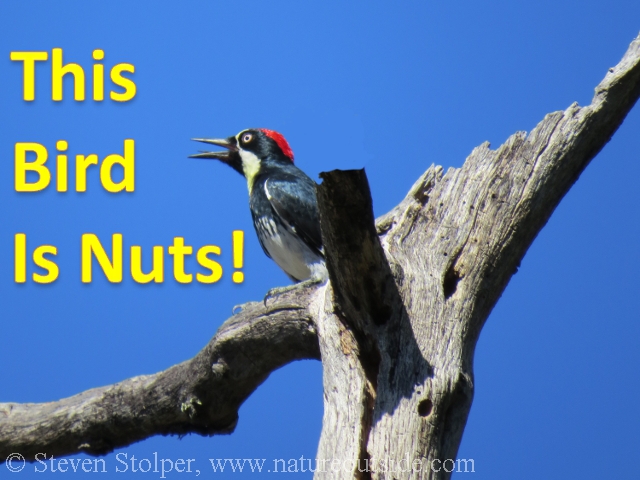
I’m hiking through a peaceful oak forest, enjoying the cool shade. The cloudless blue sky peeks through the dense canopy overhead. My boots make soft swishing sounds as they displace the dried oak and tanoak leaves lining the forest floor. On this hot day the forest is a refuge, a respite from the unrelenting sun.
I push-up the brim of my hat and unscrew the top to my water bottle. I drink in the stillness as I satisfy my thirst.
And then they arrive.
Talking Loud and Having Fun
Acorn woodpeckers (Melanerpes formicivorus) – the colorful, raucous, juvenile delinquents of the oak forest. They sweep in overhead like a gang of unruly teenagers playing music and laughing too loud. And they always seem to be laughing at me, with their “Waka, waka, waka!” calls (listen).
I can see them now, high above. Sporting leather jackets with colorful red Mohawks. The wild eyed birds laugh maniacally. And once again, I’m not cool enough to get the joke.
Their swooping flight pattern reminds me of waves on the ocean. It’s characteristically woodpecker – fast wing flaps as they rise to a peak, then they retract their wings and dip as they glide.
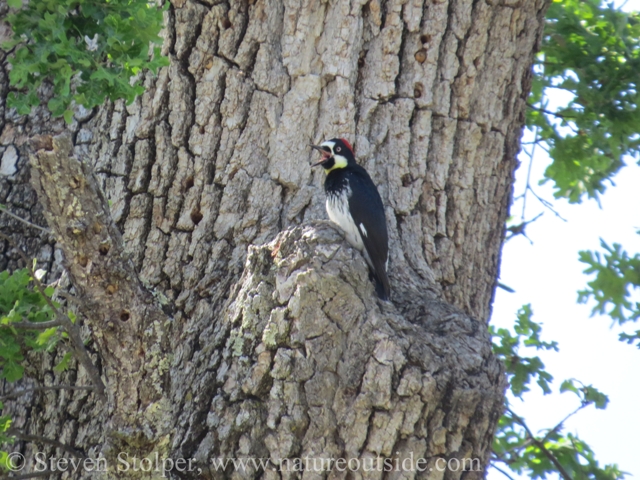
Acorn woodpecker making a ruckus as usual.
The gang alights high above me and begins to forage. They appear to defy gravity, moving laterally on the tree. They have zygodactil feet (four toes). Two face forward and two backward. This gives them a strong grip on branches and tree trunks. They use stiff tail feathers to help balance themselves.
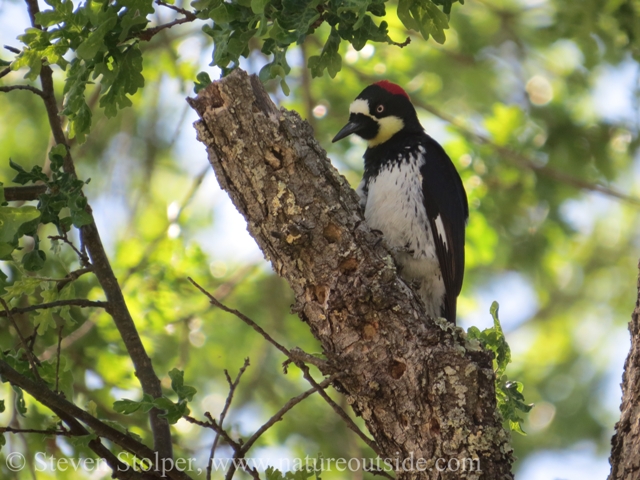
A closer look at an Acorn woodpecker.
Their skulls are adapted so they can peck into trees without suffering brain damage. Kind of like a college student who crushes beer cans against his head. Their translucent third eyelid, called a nictitating membrane, protects their eyes from flying debris. If you look closely at the pictures, you will notice the bristly feathers over their nostrils to prevent inhaling wood particles as they chisel.
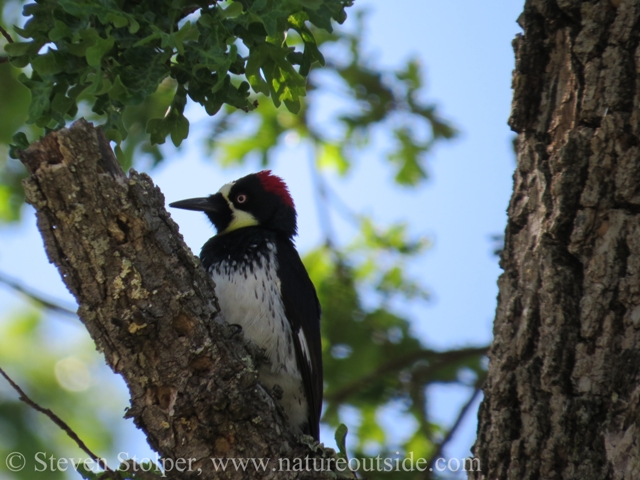
Notice the bristly hair near the nostrils to prevent inhalation of flying debris.
Granary Trees
Acorn woodpeckers usually live in areas with more than one species of oak tree. If a crop fails in one species, they have a backup food source.1
Standing dead trees and trees with dead limbs are hugely important. Acorn woodpeckers use them for an amazing purpose: granary trees.
Acorn woodpeckers cache their acorns in one or more granary trees. Each clan maintains and jealously protects its food store. A granary may hold as many as 50,000 acorns! And the birds drill an individual hole for each nut!
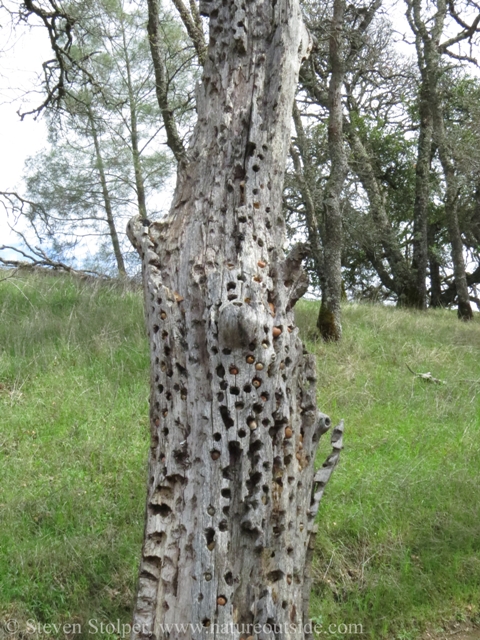
Acorn granary tree.
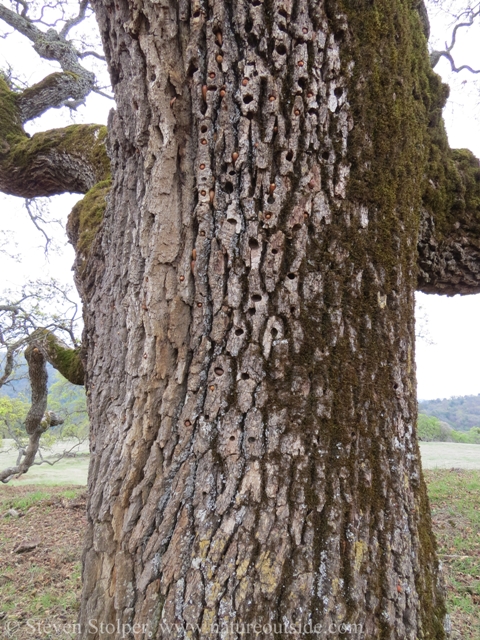
Another granary tree.
The birds jam each acorn into its hole tightly to frustrate squirrels and jays. But as the acorns age, they dry. As they do this they shrink. So the birds constantly relocate their acorns to new holes to maintain the tight fit.
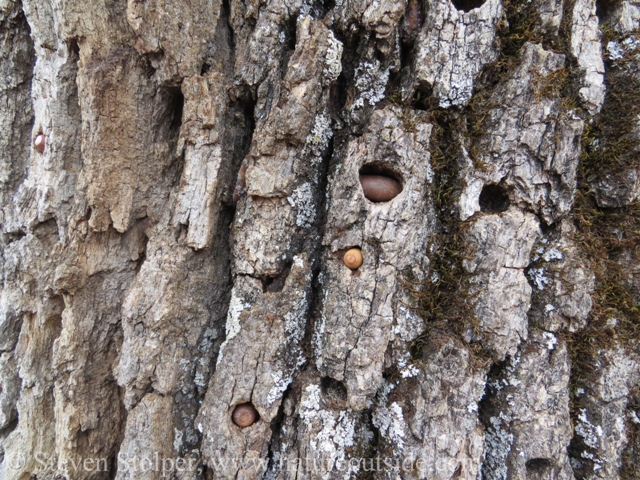
A closer look at a granary tree.
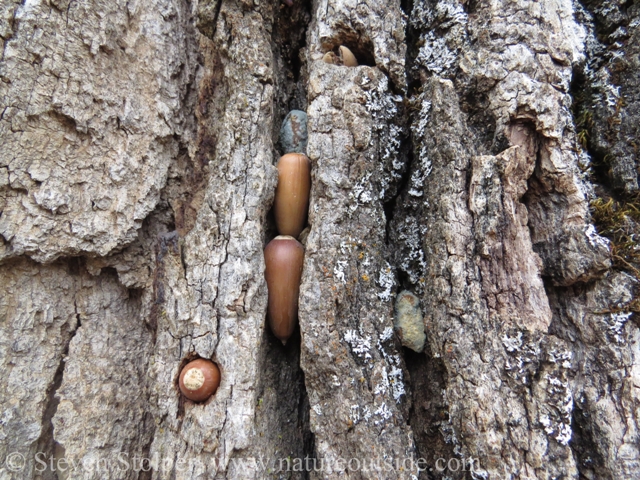
Most of the time, Acorn woodpeckers drill into the granary tree. But if they can, they will wedge them into cracks.
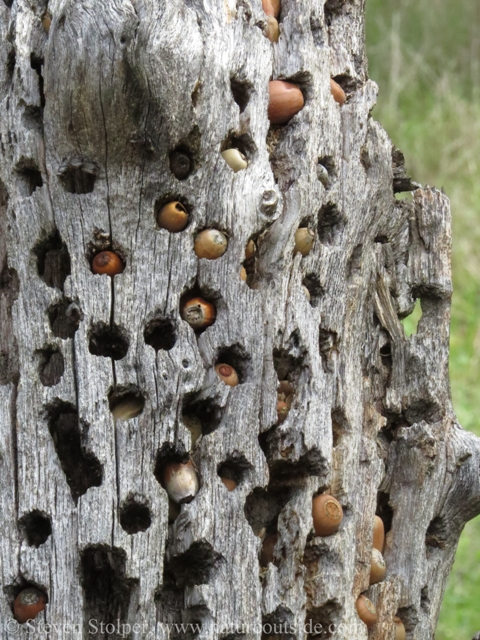
Dead trees make perfect granary trees.
Granary trees are extremely important to the birds. In a lean year for acorns, Acorn woodpeckers can starve to death. The granaries buffer them against starvation. So the birds ban together into clans that build a robust granary and protect it against all comers. The clans include nestlings, breeding females, breeding males, and the non-breeding adult children who help stock the granary and care for the nestlings.
It’s amazing that these birds provision food for the winter. And it gives them a survival advantage. The granaries obviate the need to migrate. They can stay in their territories all winter. Acorn woodpeckers avoid the danger of migration and the tremendous energy toll it takes. Instead, they enjoy a longer breeding season and can defend their territory all year long.
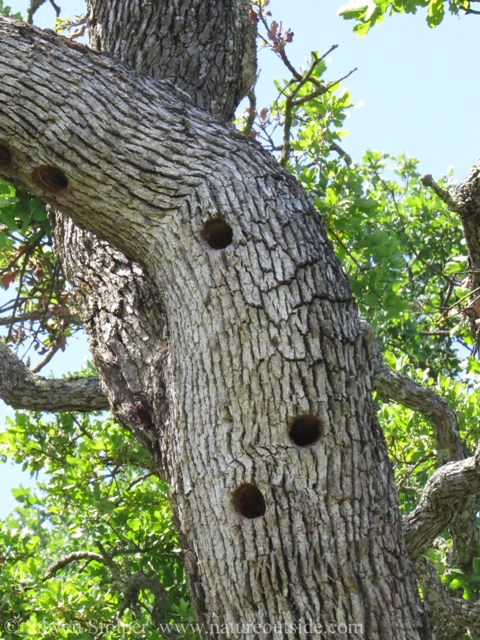
Acorn woodpecker homes.
Here comes Trouble!
The biggest threat to Acorn woodpeckers is loss of habitat. We can help by letting dead trees, called snags, stand. We can also refrain from pruning dead tree limbs. Often peoples’ instant reaction is to take down a dead tree. But dead trees provide habitat for remarkable creatures like Acorn woodpeckers.
Reacting to habitat loss, some Acorn woodpeckers have gone on the offensive. For several years I worked in a “business incubator” as my fledgling company tried to get off the ground. I enjoyed the two-story pitched-roof structures because they blended so well with their rustic surroundings.
Each morning as I walked into the office, Acorn woodpeckers showered laughter down on me from the eaves. They were mocking me for frittering my day in an office while they cavorted outside.
I remarked to the facility manager how much I enjoyed the woodpeckers. He gave me a look that made me want to shrivel and die. The birds were using our office as an acorn granary!
The mob of woodpeckers worked non-stop putting holes in the sides of our building and stuffing them with acorns. Management tried everything they could think of to dissuade the birds. Chickenwire, plastic owls – nothing seemed to work. The birds would disappear for a few days before finding a clever solution to the man-made puzzle.
When my company left the facility two years later, the birds still held the upper hand!
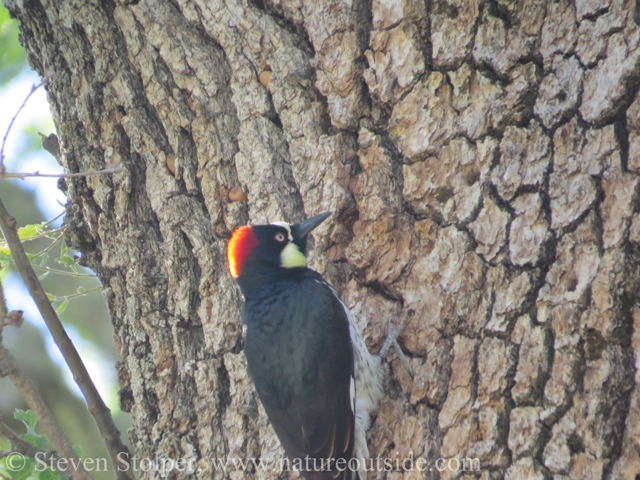
Sun reflecting off an Acorn woodpecker’s decorative cap.
That’s why I was highly amused when a friend sent me this video of another group of Acorn woodpeckers causing trouble. Now that you understand how the birds operate, you can appreciate how their woodpecker brains lit up when they saw the antenna.
Note that the video incorrectly implicates squirrels. But with our understanding of Acorn woodpecker behavior, we can finger the true culprits. This site is not far from some of my favorite hiking places.
Learn More about Acorn Woodpeckers
There is much more to learn about these amazing creatures. Acorn woodpeckers have complex family relationships. Their feathers have been used for centuries by the indigenous peoples of northern California. And there are a number of stories about Acorn woodpeckers in their mythology.
Have you encountered these mischievous creatures? Leave a comment below with your own Acorn woodpecker story.
Further Reading
1. Secrets of the Oak Woodlands: Plants and Animals Among California’s Oaks, Kate Marianchild.
2. The Sibley Guide to Bird Life and Behavior, David Allen Sibley
3. All About Birds (Website)
For fun facts and useful tips, join the free Bushcraft Newsletter.



Leave a Comment